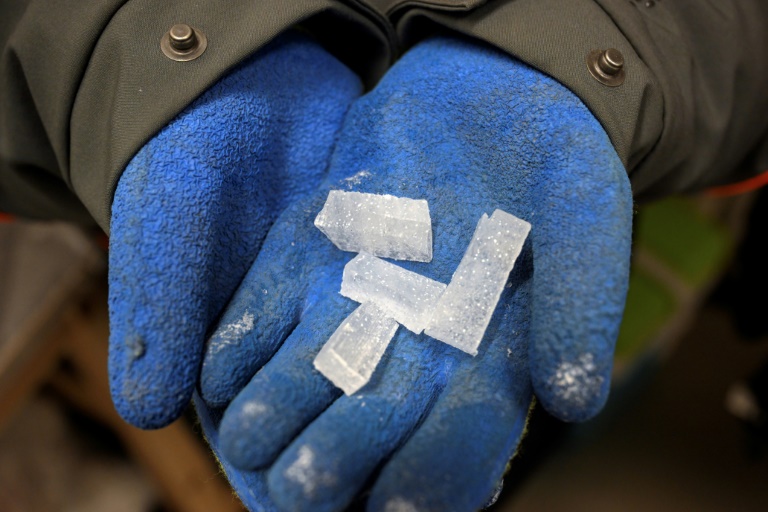World
Scientists Unearth Ancient Antarctic Ice to Unlock Climate Secrets

In a refrigerated facility at the Vrije Universiteit Brussel (VUB), researchers are meticulously examining Antarctic ice cores that date back tens of thousands of years. Their goal is to uncover vital information about the Earth’s past climate, which could offer insights into future climate scenarios. Glaciologist Harry Zekollari emphasized the importance of understanding historical climate patterns: “We want to know a lot about the climates of the past because we can use it as an analogy for what can happen in the future.”
The team’s expedition to Antarctica in November focused on locating some of the world’s oldest ice without incurring exorbitant costs. Ice that is millions of years old lies deep beneath the surface, concealed under layers of newer snow and ice. Accessing these sites can be prohibitively expensive; a recent European Union-funded mission that retrieved ice samples from 1.2 million years ago cost approximately 11 million euros (around $12.8 million). To optimize their resources, the VUB team collaborated with the nearby Universite Libre de Bruxelles (ULB) and utilized satellite data to identify more easily accessible ancient ice locations.
Exploring Blue Ice Areas
Maaike Izeboud, a remote sensing specialist at VUB, explained that ice naturally flows toward the coast, albeit at a slow pace. When this flow encounters obstacles like ridges or mountains, the lower layers can be pushed closer to the surface. In certain regions, conditions such as strong winds inhibit snow accumulation, revealing thick layers of ancient ice. These blue ice areas, which represent only about one percent of Antarctica’s landscape, are particularly valuable for research.
The team identified a blue ice zone at an altitude of approximately 2,300 meters (7,500 feet), located around 60 kilometers (37 miles) from Belgium’s Princess Elisabeth Antarctica Research Station. Previous meteorite discoveries in this area suggested that the surrounding ice could also be ancient. After establishing a temporary camp, the researchers spent weeks measuring and drilling, ultimately returning in January with 15 ice cores totaling around 60 meters in length. These samples were transported from South Africa to Belgium, arriving in late June.
Inside a ULB facility in Brussels, the cores are currently being sliced into smaller sections for further analysis. The team hopes that some of the samples, taken from depths of about 10 meters, will be around 100,000 years old.
Aiming for the Oldest Ice
Zekollari described the endeavor as akin to a treasure hunt, where each discovery leads to further exploration. “It’s like a treasure hunt,” he remarked, comparing their efforts to an adventure map for “Indiana Jones.” Should their current findings confirm the presence of ancient ice, the researchers plan to return in approximately 18 months to drill deeper for even older samples. “We’re dreaming a bit, but we hope to get maybe three, four, or five million-year-old ice,” he added.
Such ancient ice could provide critical data for climatologists investigating the implications of global warming. Current climate models are calibrated using historical data on temperature and greenhouse gas levels, but gaps in this information exist. According to paleo-climatologist Etienne Legrain, by the end of the century, global temperatures could mirror those last seen between 2.6 and 3.3 million years ago. However, there is limited data on carbon dioxide (CO2) levels from that era, a crucial factor in understanding potential future warming.
Legrain stated, “We don’t know the link between CO2 concentration and temperature in a climate warmer than that of today.” His team is hopeful that air bubbles trapped within the ancient ice will provide the missing data. “The air bubbles are the atmosphere of the past,” he said, expressing wonder at the significance of their findings. “It’s really like magic when you feel it.”
As these scientists continue their research, the implications of their discoveries may extend far beyond academics, potentially influencing climate policy and public understanding of our planet’s future.
-

 Politics4 weeks ago
Politics4 weeks agoSecwepemc First Nation Seeks Aboriginal Title Over Kamloops Area
-

 Entertainment5 months ago
Entertainment5 months agoTrump and McCormick to Announce $70 Billion Energy Investments
-

 Science5 months ago
Science5 months agoFour Astronauts Return to Earth After International Space Station Mission
-

 Lifestyle5 months ago
Lifestyle5 months agoTransLink Launches Food Truck Program to Boost Revenue in Vancouver
-

 Technology3 months ago
Technology3 months agoApple Notes Enhances Functionality with Markdown Support in macOS 26
-

 Lifestyle3 months ago
Lifestyle3 months agoManitoba’s Burger Champion Shines Again Amid Dining Innovations
-

 Top Stories2 months ago
Top Stories2 months agoUrgent Update: Fatal Crash on Highway 99 Claims Life of Pitt Meadows Man
-

 Politics4 months ago
Politics4 months agoUkrainian Tennis Star Elina Svitolina Faces Death Threats Online
-

 Sports5 months ago
Sports5 months agoSearch Underway for Missing Hunter Amid Hokkaido Bear Emergency
-

 Politics5 months ago
Politics5 months agoCarney Engages First Nations Leaders at Development Law Summit
-

 Technology5 months ago
Technology5 months agoFrosthaven Launches Early Access on July 31, 2025
-

 Top Stories1 month ago
Top Stories1 month agoFamily Remembers Beverley Rowbotham 25 Years After Murder






















